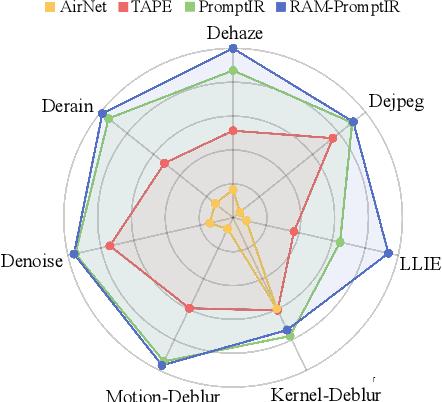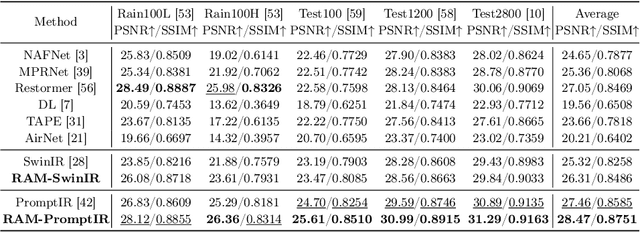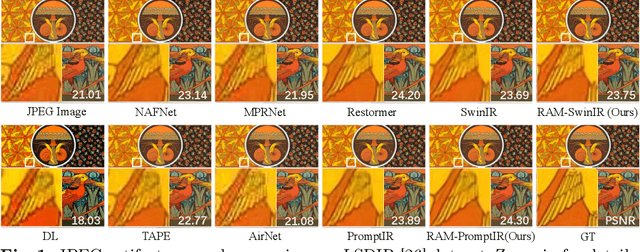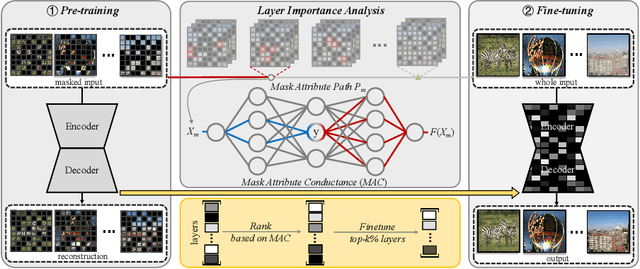Chongyi Li
Classic Video Denoising in a Machine Learning World: Robust, Fast, and Controllable
Apr 04, 2025Abstract:Denoising is a crucial step in many video processing pipelines such as in interactive editing, where high quality, speed, and user control are essential. While recent approaches achieve significant improvements in denoising quality by leveraging deep learning, they are prone to unexpected failures due to discrepancies between training data distributions and the wide variety of noise patterns found in real-world videos. These methods also tend to be slow and lack user control. In contrast, traditional denoising methods perform reliably on in-the-wild videos and run relatively quickly on modern hardware. However, they require manually tuning parameters for each input video, which is not only tedious but also requires skill. We bridge the gap between these two paradigms by proposing a differentiable denoising pipeline based on traditional methods. A neural network is then trained to predict the optimal denoising parameters for each specific input, resulting in a robust and efficient approach that also supports user control.
A Diffusion-Based Framework for Occluded Object Movement
Apr 02, 2025Abstract:Seamlessly moving objects within a scene is a common requirement for image editing, but it is still a challenge for existing editing methods. Especially for real-world images, the occlusion situation further increases the difficulty. The main difficulty is that the occluded portion needs to be completed before movement can proceed. To leverage the real-world knowledge embedded in the pre-trained diffusion models, we propose a Diffusion-based framework specifically designed for Occluded Object Movement, named DiffOOM. The proposed DiffOOM consists of two parallel branches that perform object de-occlusion and movement simultaneously. The de-occlusion branch utilizes a background color-fill strategy and a continuously updated object mask to focus the diffusion process on completing the obscured portion of the target object. Concurrently, the movement branch employs latent optimization to place the completed object in the target location and adopts local text-conditioned guidance to integrate the object into new surroundings appropriately. Extensive evaluations demonstrate the superior performance of our method, which is further validated by a comprehensive user study.
DiT4SR: Taming Diffusion Transformer for Real-World Image Super-Resolution
Mar 30, 2025Abstract:Large-scale pre-trained diffusion models are becoming increasingly popular in solving the Real-World Image Super-Resolution (Real-ISR) problem because of their rich generative priors. The recent development of diffusion transformer (DiT) has witnessed overwhelming performance over the traditional UNet-based architecture in image generation, which also raises the question: Can we adopt the advanced DiT-based diffusion model for Real-ISR? To this end, we propose our DiT4SR, one of the pioneering works to tame the large-scale DiT model for Real-ISR. Instead of directly injecting embeddings extracted from low-resolution (LR) images like ControlNet, we integrate the LR embeddings into the original attention mechanism of DiT, allowing for the bidirectional flow of information between the LR latent and the generated latent. The sufficient interaction of these two streams allows the LR stream to evolve with the diffusion process, producing progressively refined guidance that better aligns with the generated latent at each diffusion step. Additionally, the LR guidance is injected into the generated latent via a cross-stream convolution layer, compensating for DiT's limited ability to capture local information. These simple but effective designs endow the DiT model with superior performance in Real-ISR, which is demonstrated by extensive experiments. Project Page: https://adam-duan.github.io/projects/dit4sr/.
Iterative Predictor-Critic Code Decoding for Real-World Image Dehazing
Mar 17, 2025Abstract:We propose a novel Iterative Predictor-Critic Code Decoding framework for real-world image dehazing, abbreviated as IPC-Dehaze, which leverages the high-quality codebook prior encapsulated in a pre-trained VQGAN. Apart from previous codebook-based methods that rely on one-shot decoding, our method utilizes high-quality codes obtained in the previous iteration to guide the prediction of the Code-Predictor in the subsequent iteration, improving code prediction accuracy and ensuring stable dehazing performance. Our idea stems from the observations that 1) the degradation of hazy images varies with haze density and scene depth, and 2) clear regions play crucial cues in restoring dense haze regions. However, it is non-trivial to progressively refine the obtained codes in subsequent iterations, owing to the difficulty in determining which codes should be retained or replaced at each iteration. Another key insight of our study is to propose Code-Critic to capture interrelations among codes. The Code-Critic is used to evaluate code correlations and then resample a set of codes with the highest mask scores, i.e., a higher score indicates that the code is more likely to be rejected, which helps retain more accurate codes and predict difficult ones. Extensive experiments demonstrate the superiority of our method over state-of-the-art methods in real-world dehazing.
FaceMe: Robust Blind Face Restoration with Personal Identification
Jan 10, 2025Abstract:Blind face restoration is a highly ill-posed problem due to the lack of necessary context. Although existing methods produce high-quality outputs, they often fail to faithfully preserve the individual's identity. In this paper, we propose a personalized face restoration method, FaceMe, based on a diffusion model. Given a single or a few reference images, we use an identity encoder to extract identity-related features, which serve as prompts to guide the diffusion model in restoring high-quality and identity-consistent facial images. By simply combining identity-related features, we effectively minimize the impact of identity-irrelevant features during training and support any number of reference image inputs during inference. Additionally, thanks to the robustness of the identity encoder, synthesized images can be used as reference images during training, and identity changing during inference does not require fine-tuning the model. We also propose a pipeline for constructing a reference image training pool that simulates the poses and expressions that may appear in real-world scenarios. Experimental results demonstrate that our FaceMe can restore high-quality facial images while maintaining identity consistency, achieving excellent performance and robustness.
EvalMuse-40K: A Reliable and Fine-Grained Benchmark with Comprehensive Human Annotations for Text-to-Image Generation Model Evaluation
Dec 24, 2024Abstract:Recently, Text-to-Image (T2I) generation models have achieved significant advancements. Correspondingly, many automated metrics have emerged to evaluate the image-text alignment capabilities of generative models. However, the performance comparison among these automated metrics is limited by existing small datasets. Additionally, these datasets lack the capacity to assess the performance of automated metrics at a fine-grained level. In this study, we contribute an EvalMuse-40K benchmark, gathering 40K image-text pairs with fine-grained human annotations for image-text alignment-related tasks. In the construction process, we employ various strategies such as balanced prompt sampling and data re-annotation to ensure the diversity and reliability of our benchmark. This allows us to comprehensively evaluate the effectiveness of image-text alignment metrics for T2I models. Meanwhile, we introduce two new methods to evaluate the image-text alignment capabilities of T2I models: FGA-BLIP2 which involves end-to-end fine-tuning of a vision-language model to produce fine-grained image-text alignment scores and PN-VQA which adopts a novel positive-negative VQA manner in VQA models for zero-shot fine-grained evaluation. Both methods achieve impressive performance in image-text alignment evaluations. We also use our methods to rank current AIGC models, in which the results can serve as a reference source for future study and promote the development of T2I generation. The data and code will be made publicly available.
Paint Bucket Colorization Using Anime Character Color Design Sheets
Oct 25, 2024



Abstract:Line art colorization plays a crucial role in hand-drawn animation production, where digital artists manually colorize segments using a paint bucket tool, guided by RGB values from character color design sheets. This process, often called paint bucket colorization, involves two main tasks: keyframe colorization, where colors are applied according to the character's color design sheet, and consecutive frame colorization, where these colors are replicated across adjacent frames. Current automated colorization methods primarily focus on reference-based and segment-matching approaches. However, reference-based methods often fail to accurately assign specific colors to each region, while matching-based methods are limited to consecutive frame colorization and struggle with issues like significant deformation and occlusion. In this work, we introduce inclusion matching, which allows the network to understand the inclusion relationships between segments, rather than relying solely on direct visual correspondences. By integrating this approach with segment parsing and color warping modules, our inclusion matching pipeline significantly improves performance in both keyframe colorization and consecutive frame colorization. To support our network's training, we have developed a unique dataset named PaintBucket-Character, which includes rendered line arts alongside their colorized versions and shading annotations for various 3D characters. To replicate industry animation data formats, we also created color design sheets for each character, with semantic information for each color and standard pose reference images. Experiments highlight the superiority of our method, demonstrating accurate and consistent colorization across both our proposed benchmarks and hand-drawn animations.
Underwater Object Detection in the Era of Artificial Intelligence: Current, Challenge, and Future
Oct 08, 2024Abstract:Underwater object detection (UOD), aiming to identify and localise the objects in underwater images or videos, presents significant challenges due to the optical distortion, water turbidity, and changing illumination in underwater scenes. In recent years, artificial intelligence (AI) based methods, especially deep learning methods, have shown promising performance in UOD. To further facilitate future advancements, we comprehensively study AI-based UOD. In this survey, we first categorise existing algorithms into traditional machine learning-based methods and deep learning-based methods, and summarise them by considering learning strategy, experimental dataset, utilised features or frameworks, and learning stage. Next, we discuss the potential challenges and suggest possible solutions and new directions. We also perform both quantitative and qualitative evaluations of mainstream algorithms across multiple benchmark datasets by considering the diverse and biased experimental setups. Finally, we introduce two off-the-shelf detection analysis tools, Diagnosis and TIDE, which well-examine the effects of object characteristics and various types of errors on detectors. These tools help identify the strengths and weaknesses of detectors, providing insigts for further improvement. The source codes, trained models, utilised datasets, detection results, and detection analysis tools are public available at \url{https://github.com/LongChenCV/UODReview}, and will be regularly updated.
Restore Anything with Masks: Leveraging Mask Image Modeling for Blind All-in-One Image Restoration
Sep 28, 2024



Abstract:All-in-one image restoration aims to handle multiple degradation types using one model. This paper proposes a simple pipeline for all-in-one blind image restoration to Restore Anything with Masks (RAM). We focus on the image content by utilizing Mask Image Modeling to extract intrinsic image information rather than distinguishing degradation types like other methods. Our pipeline consists of two stages: masked image pre-training and fine-tuning with mask attribute conductance. We design a straightforward masking pre-training approach specifically tailored for all-in-one image restoration. This approach enhances networks to prioritize the extraction of image content priors from various degradations, resulting in a more balanced performance across different restoration tasks and achieving stronger overall results. To bridge the gap of input integrity while preserving learned image priors as much as possible, we selectively fine-tuned a small portion of the layers. Specifically, the importance of each layer is ranked by the proposed Mask Attribute Conductance (MAC), and the layers with higher contributions are selected for finetuning. Extensive experiments demonstrate that our method achieves state-of-the-art performance. Our code and model will be released at \href{https://github.com/Dragonisss/RAM}{https://github.com/Dragonisss/RAM}.
Kalman-Inspired Feature Propagation for Video Face Super-Resolution
Aug 09, 2024Abstract:Despite the promising progress of face image super-resolution, video face super-resolution remains relatively under-explored. Existing approaches either adapt general video super-resolution networks to face datasets or apply established face image super-resolution models independently on individual video frames. These paradigms encounter challenges either in reconstructing facial details or maintaining temporal consistency. To address these issues, we introduce a novel framework called Kalman-inspired Feature Propagation (KEEP), designed to maintain a stable face prior over time. The Kalman filtering principles offer our method a recurrent ability to use the information from previously restored frames to guide and regulate the restoration process of the current frame. Extensive experiments demonstrate the effectiveness of our method in capturing facial details consistently across video frames. Code and video demo are available at https://jnjaby.github.io/projects/KEEP.
 Add to Chrome
Add to Chrome Add to Firefox
Add to Firefox Add to Edge
Add to Edge